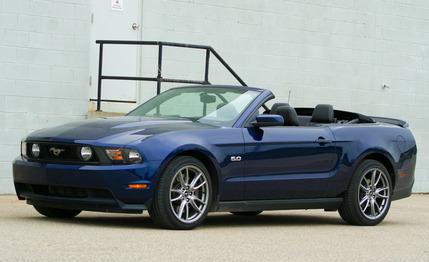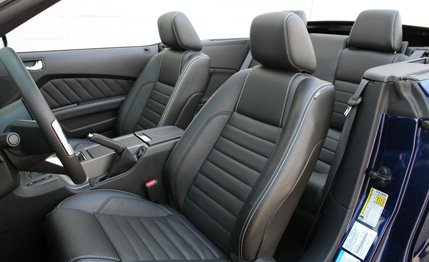 Short Take Road Test
Short Take Road Test

Although the pony-car rivalry was an even fight through the 1980s and turned into Camaro domination by the late ‘90s, the tables have tilted toward the Ford Mustang of late. Indeed, the 2011 Mustang GT 5.0 and V-6 coupes are the freshest Camaro slayers, having triumphed in two recent comparison tests. But we couldn’t wait until next year for the Camaro convertible and the attendant comparo to put the 2011 Mustang convertible through its paces. We wanted to know now if we’d find the convertible as thrilling as its tin-top sibling.
Mustang’s Hierarchy of Needs
First and foremost, a thrilling car needs responsive and predictable underpinnings. The 2011 Ford Mustang GT convertible is slightly stiffer from the 2010 model, but the improvements are minor. A strut-tower brace is standard now on droptops, and measures have been taken throughout the nose of the car to firm it up. Total weight gain in the convertible is 56 pounds.

Still, the Mustang remains a pretty big car; the convertible, a pretty big car with a pretty big roof cut off. A pronounced cowl quiver results, and both coupe—which has some steering-wheel shakes of its own—and convertible can at times feel too close to their 1960s forebears than we’d like. In rapid transitions, the body and chassis of the droptop feel a bit disconnected, like a mag-lev train with a cushion of air between the train and track. As a result, this Mustang suffers from a slight delay between driver action and vehicle reaction.
Rubber that was less grippy than the comparo-winning coupe’s had the convertible slipping off the skidpad 0.06 g sooner, although 0.88 g—the coupe scored a 0.94—will still elicit howling from passengers as easily as it will from the tires. Most of the difference is attributable to the coupe’s ultra-sticky Pirelli P Zero rubber. The convertible we tested made do with Goodyear Eagle F1 Supercars in the same 255/40-19 size. With either tire, though, once the Mustang takes a set, it is imperturbable, impressive considering the log axle riding beneath the back seat. Unless, of course, the driver wants to perturb the 5.0; sideways is just a heavy hand—and foot—away.
Warning: Kissin’ Cousins Could Blow Your Engine
Although the flimsier body structure dilutes steering feel a tad, the wheel offers more feedback than we expected from an electric power-steering system. It seems some manufacturers—including Ford—are figuring out how to tune this technology for enthusiasts. “More feedback than we expected” is not, however, enough, and there remains a whiff of artificiality.
The clutch and the shifter need some refinement. Clutch engagement is long, heavy, and numb. Smooth starts aren’t a challenge, but smooth starts without lugging or over-revving the engine are. And the shifter gates are closer than kissin’ cousins. With mere millimeters between first and third, we found wide-open two-three shifts slowed by our Hail Marys, after which we still grabbed fifth instead of third.
Neither are the brakes particularly satisfying, although the $1695 Brembo brake package needs not a communicative pedal to pepper the dash with your fillings. Stomp on the middle pad at 70 mph, and you’ll screech to a halt in 162 feet. At least the throttle is whip-crack quick, responding immediately yet providing enough travel to carefully modulate the herd underhood.
The one thing the Mustang GT convertible inarguably lords over the coupe is more direct access to the howling of the 5.0, known during its development as the Coyote. Had Wile E. Coyote had 412 hp at his disposal, a lot more kids might have been traumatized by Looney Tunes episodes of old. Sixty mph comes from rest in 4.7 seconds, and Road Runner’s bones will be a quarter-mile back after just 13.2 seconds, at which point the Mustang is traveling 108 mph. All the while, there’s a familiar V-8 barrage pouring from the GT’s dual exhaust, registering a decidedly uncivil 84 decibels at full throttle—with the top up. But the coupe registered 85 decibels, and the thick convertible top keeps the interior quiet during calmer driving. We needed to raise our voices only during a spring thunder- and hailstorm that had area farmers herding their animals two by two.
A Princely Price for a Pony
Then again, for $41,765, it had better be quiet. Say whaaaaat? Mustang convertibles carry a $5000 premium over coupes, so a GT convertible starts at $35,495. Add to that the $3200 Premium package, which nets power leather seats, a leather-wrapped steering wheel, a Shaker stereo with Sirius satellite radio, Sync, aluminum pedals, upgraded interior lighting, and bright aluminum dash appliqués that blind passengers on sunny days—a major snafu in a car meant for just that kind of day. Then top it off with those Brembo brakes, a rearview camera ($385), a power passenger’s seat and heat for both the fronts ($595), and the Security package (an alarm and wheel locks for $395), and you’ve built a twin for our tester. At $42,000, it’s within $7000 of the 540-hp Shelby GT500 coupe.

That likely doesn’t matter to Mustang convertible buyers. Obviously, the coupe is the more sporting model. Obviously, the convertible is a compromise. Cut off Samson’s locks, he loses his strength. Cut off the Mustang’s roof, it loses its sharp edge. Buying the droptop is a lifestyle decision, and to some customers, the elemental exposure is worth the trade-off in absolute performance. But we think the convertible gives up too much of the Mustang’s sportiness.